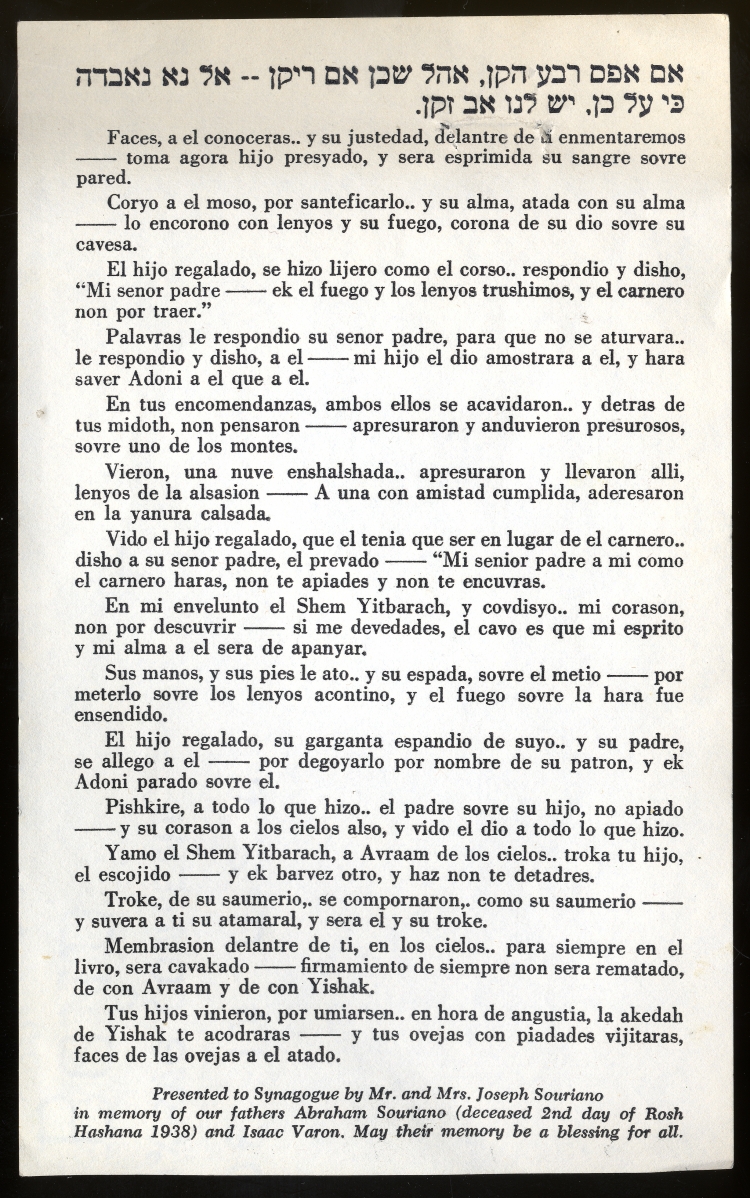“Im Afes,” A Moving Poem about the Binding of Isaac
A Rosh Hashanah treasure that Joseph Souriano printed for the Sephardic community is the heart-wrenching piyyut (liturgical poem) entitled Im Afes, based on the biblical story of the binding of Isaac, which is read every Rosh Hashana. The original Hebrew song was authored by Rabbi Ephraim Yitzhak of Regensburg (ca. 12th century Bavaria, Germany) and was included in the liturgy of many Sephardic communities. This poem was the inspiration for the Ladino rendition (not a literal translation), which begins with the words “Fases, a el conoseras” [Show him favor or Pay heed to him].

Page of Im Afes. Courtesy of the Sephardic Studies Digital Library & Museum.
This was customarily sung on Rosh Hashana in the synagogues of Istanbul, Marmara, Tekirdag and Rhodes, where many of the first generation of Seattle Sephardim were raised. However, this song was not included in the most commonly used mahzor (holiday prayer book) in Seattle, the Mahzor le-Rosh ha-Shanah Minhag Sefarad be-Keilot Kedoshot Konstantina published in Vienna.
Elaborating on the akedat Yitzhak, the binding of Isaac, this moving poem describes the emotional telling of the Jewish patriarch Abraham preparing his son Isaac as an offering upon the altar. In tribute to his father Abraham, who passed away on Rosh Hashana and his father-in-law Isaac, Souriano ensured that his community would continue to sing this song of sacrifice in their mother tongue in their new home in America.
Original Text:
Coryo a el moso por santeficarlo,
y su alma, atada con su alma,
Lo encorono con lenyos y su fuego,
Corona de su Dio sovre su cavesa,
Translation:
He hurried to the child to hallow him,
Even though his soul was attached to him
He surrounded him with wood and fire,
Like a crown of God upon his head. *
*1. Translation by Rabbi Yossi Azose. Source: Isaac Azose’s Mahzor Tefilah Le-David Le-Rosh Ashana (According to the Rhodes Tradition). Sephardic Traditions Foundation, 2011.
View the full item at this link in the Sephardic Studies Digital Library.
Links for Further Exploration
- Sephardic New Year Cards and a Seattle Printing Press by Ty Alhadeff (Sept. 6, 2015)
- What are Sephardic Rosh Hashana customs? by Ty Alhadeff (Sept. 24, 2014)







Thanks to Ty Alhadeff for this great and timely article.It is a tribute to my father Joseph Souriano and to my family. Ty also wrote a great article involving Rosh Hashana/Jewish New Year cards that were sent to my parents. Thanks for making me even more proud of our heritage and contribtions to the community.
Marlene Souriano-Vinikoor
Regarding Im Afes, When we start singing Im Afes, we are singing the first stanza of the song. It continues with the second stanza which starts ‘Fases, a El Konoseras. the 3rd stanza begins which appears above is Coryo a El Moso,.